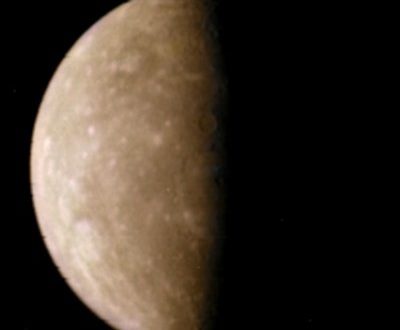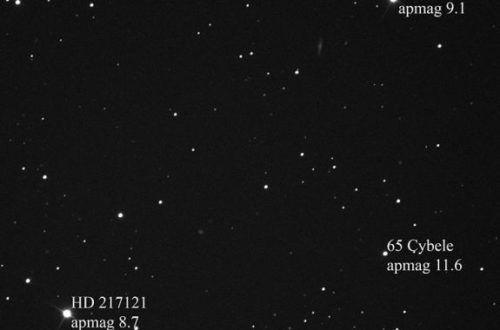Stargazing Calendar for February 2024
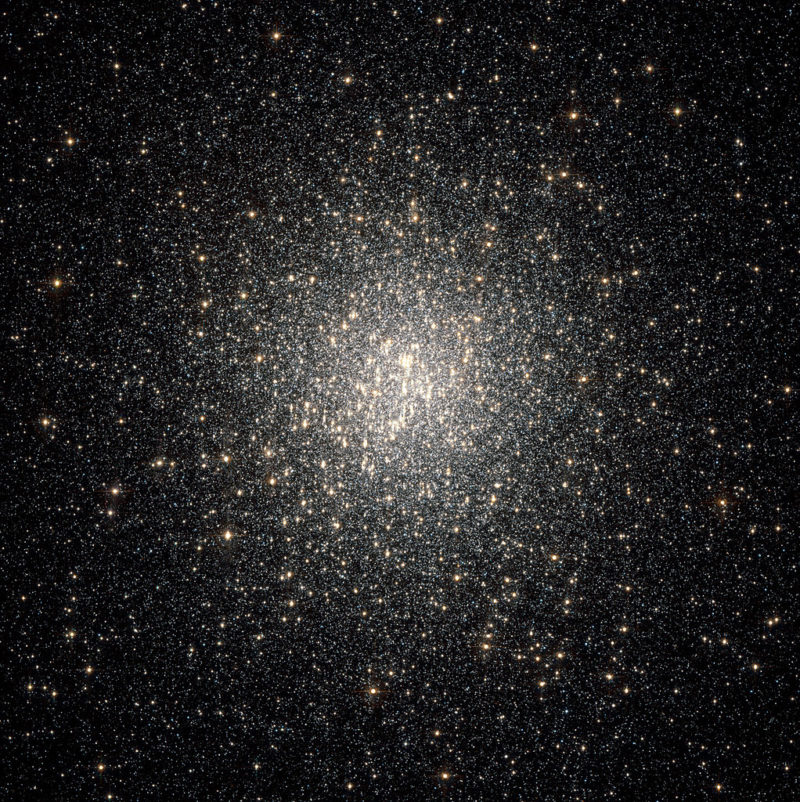
Looking for the February 2025 stargazing calendar?
Get ready to witness an extraordinary celestial showcase for stargazing this February 2024! From planetary conjunctions to comet and meteor sightings, the night sky is poised to dazzle stargazers with its cosmic wonders. Join us as we explore the celestial ballet unfolding above, offering a glimpse into the captivating beauty of our universe.
Would you like to be notified of stargazing events?
List of Meteor Showers in February 2024
- December Leonis Minorids: Start on December 5; peak on December 20; end on February 4.
- Antihelion Source: Start on December 10; multiple peaks; end September 10.
- α-Centaurids: Start on January 28; peak on February 8; end on February 21.
- γ-Normids: Start on February 25; peak on March 14; end on March 28.
We also have a complete list of meteor showers for the entire year here.
List of Planetary Conjunctions in February 2024
- Conjunction of Mercury and Pluto in Capricornus on February 5.
- Conjunction of the Moon and Venus in Sagittarius on February 7.
- Conjunction of the Moon and Mars in Sagittarius on February 8.
- Conjunction of the Moon and Mercury in Capricornus on February 8.
- Conjunction of the Moon and Saturn in Aquarius on February 10.
- Conjunction of the Moon and Jupiter in Aries on February 15.
- Conjunction of Mars and Pluto in Capricornus on February 15.
- Conjunction of Venus and Pluto in Capricornus on February 17.
- Conjunction of Venus and Mars in Capricornus on February 22.
February 5: Conjunction of Mercury and Pluto
Mercury and Pluto will reach conjunction passing within 1°20′ of each other while sharing the same right ascension.
The planet Mercury will be at apparent magnitude -0.4 while dwarf planet Pluto will be at magnitude 15.1, both in the constellation of Capricornus. The Moon will not interfere much with stargazing this early February 2024 because it will be a 25 days old waning crescent at only 16%.
Interestingly this month, just like the previous, will have a clustering of conjunctions within mere days of each other (or less). This is why you will find Mercury, Mars, and Venus nearby waiting for their respective conjunctions in the following days.

February 7: Conjunction of the Moon and Venus
The Moon and Venus will reach conjunction passing within 5°25′ of each other while sharing the same right ascension.
The Moon will be at apparent magnitude -9.9 and Venus at magnitude -4.0 both in the constellation of Sagittarius. By then, the Moon would have faded to a mere 4% of its size – a 27 days old waning crescent.
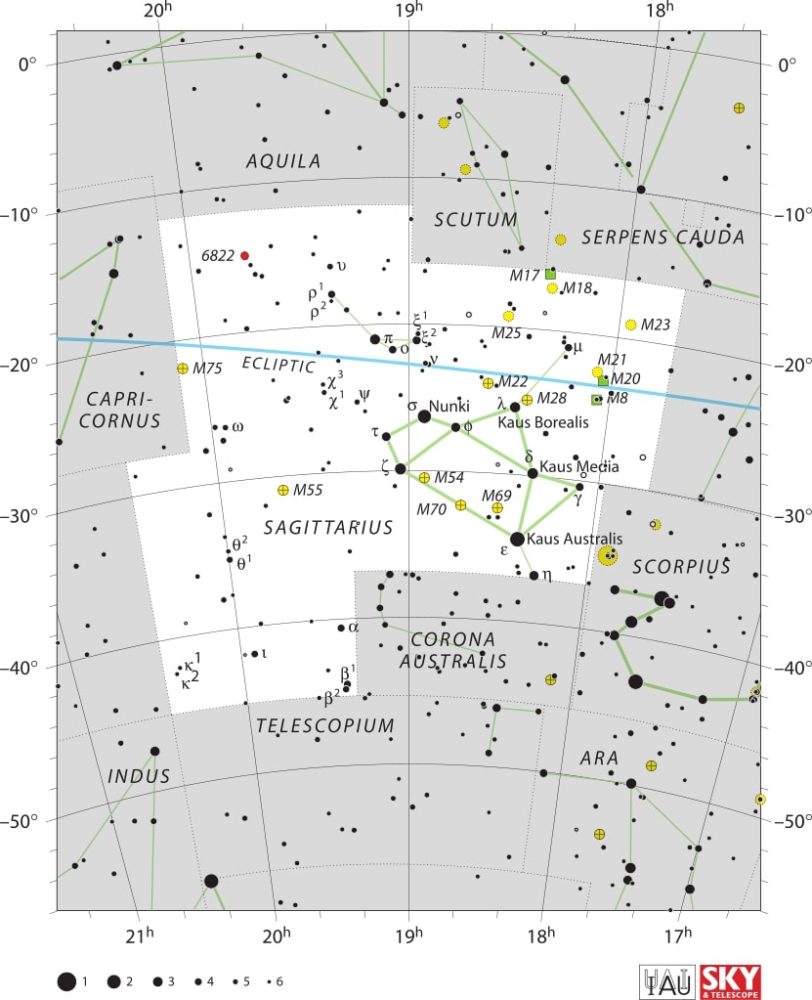
February 8: NGC 2808 at its highest point in the sky
NGC 2808 (see featured image at the top of this article) is a globular cluster in the constellation of Carina in our Milky Way galaxy. The cluster will reach its highest point in the sky at around midnight local time.
The cluster will reach apparent magnitude 6.2, so a pair of binoculars or a small telescope is recommended for optimal viewing. The Moon will not interfere with stargazing as it will be very close to new moon at at 28 days old.
This object is one of our galaxy’s most massive clusters, containing more than a million stars and is estimated to be as much as 12.5 billion years old. It is located 31,300 light-years away.
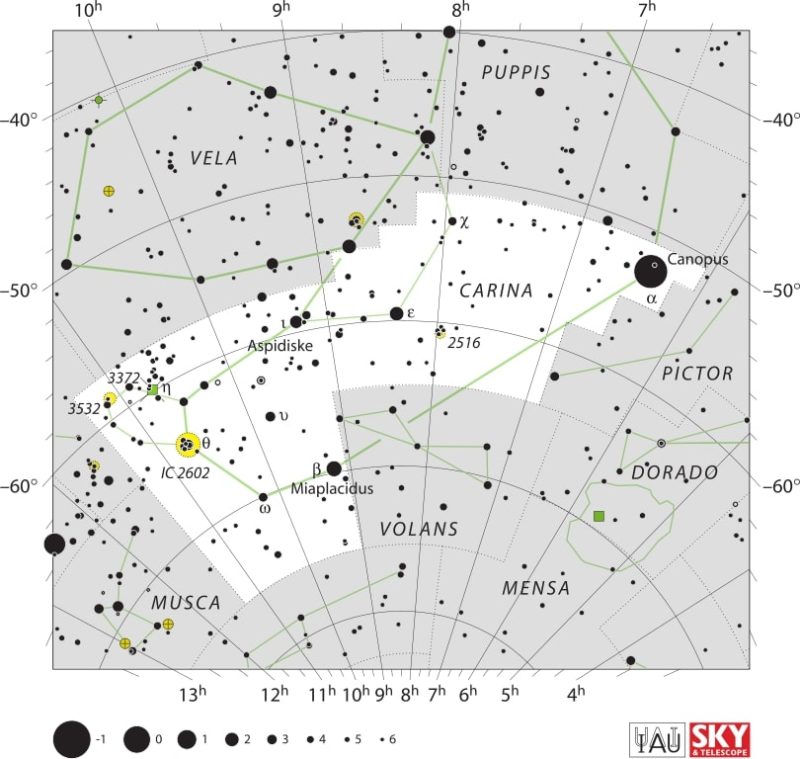
February 8: Conjunction of the Moon and Mars
The Moon and Mars will be at conjunction by sharing the same right ascension and passing within 4°12′ of each other.
Look for the two bodies in the constellation of Sagittarius. (Constellation map already displayed above, when discussing the conjunction of the Moon and Venus.)
The Moon will be a very thin waning crescent (2%) at 28 days old, very close to new moon. Despite this, the Moon will still be at apparent magnitude of -9.4, while Mars will be at magnitude 1.3.
February 8: Conjunction of the Moon and Mercury
The Moon and Mercury will pass within 3°12′ of each other while sharing the same right ascension, in what is called a planetary conjunction.
The two celestial bodies will be in the constellation of Capricornus, with the Moon at apparent magnitude -8.5, and Mercury at -0.5. The Moon will be a 28 days old very thin waning crescent very close to new moon. (Constellation map already displayed above, when discussing the conjunction of Mercury and Pluto.)
As Mercury is always close to the Sun, be very careful to not point binoculars or a telescope directly at the Sun. This can gravely damage your eyes, even resulting in permanent blindness.
February 8: α-Centaurid meteor shower peak
The Alpha Centaurids will peak with a zenithal hourly rate of 6 meteors if conditions are optimal. Those conditions could be very close to optimal as the Moon will be only a day away from the new moon phase.
Some meteors may also be spotted between January 28 and February 21. They will radiate from the constellation of Centaurus at the speed of 56 km/s on average.
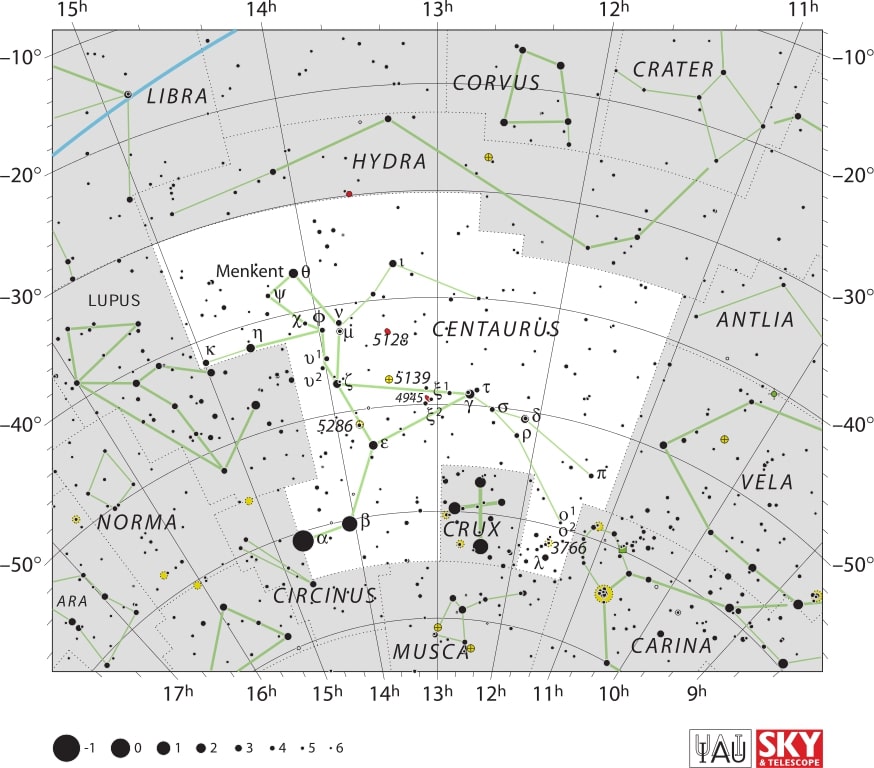
February 10: Conjunction of the Moon and Saturn
The Moon and Saturn will reach conjunction by passing within 1°48′ from each other while sharing the same right ascension.
The two bodies will meet in the constellation of Aquarius with an apparent magnitude of -8.5 for the Moon and 0.9 for Saturn. The Moon will be a one day old waxing crescent at 3%.

February 12: Lunar occultation of Neptune
The Moon will pass in front of Neptune, creating a lunar occultation, but only visible from a few islands in the Pacific Ocean near Australia and New Guinea. Outside of that area, it will be visible as a close approach (or appulse) instead. This is because the Moon is so close to the Earth (relatively speaking) that its position in the sky varies based on where you are on Earth. This variability can be as much as two degrees in some areas.
Neptune will be at apparent magnitude 7.9 (when not being occulted) in the constellation of Pisces. The Moon will be a 3 days old waxing crescent at 11%.

February 14: Comet C/2021 S3 (PANSTARRS) at perihelion
The comet C/2021 S3 (PANSTARRS) will reach perihelion on February 14, meaning it will reach the closest point in its orbit to the Sun at a distance of 1.32 AU. Despite this, it will have an apparent magnitude of only 9.4, so you’ll need a large telescope to observe this comet. If you have access to such a telescope, look in the constellation of Ophiuchus.
I would not advise to make this perihelion into a Saint Valentine’s date unless your date is into astronomy. You’ve been warned!
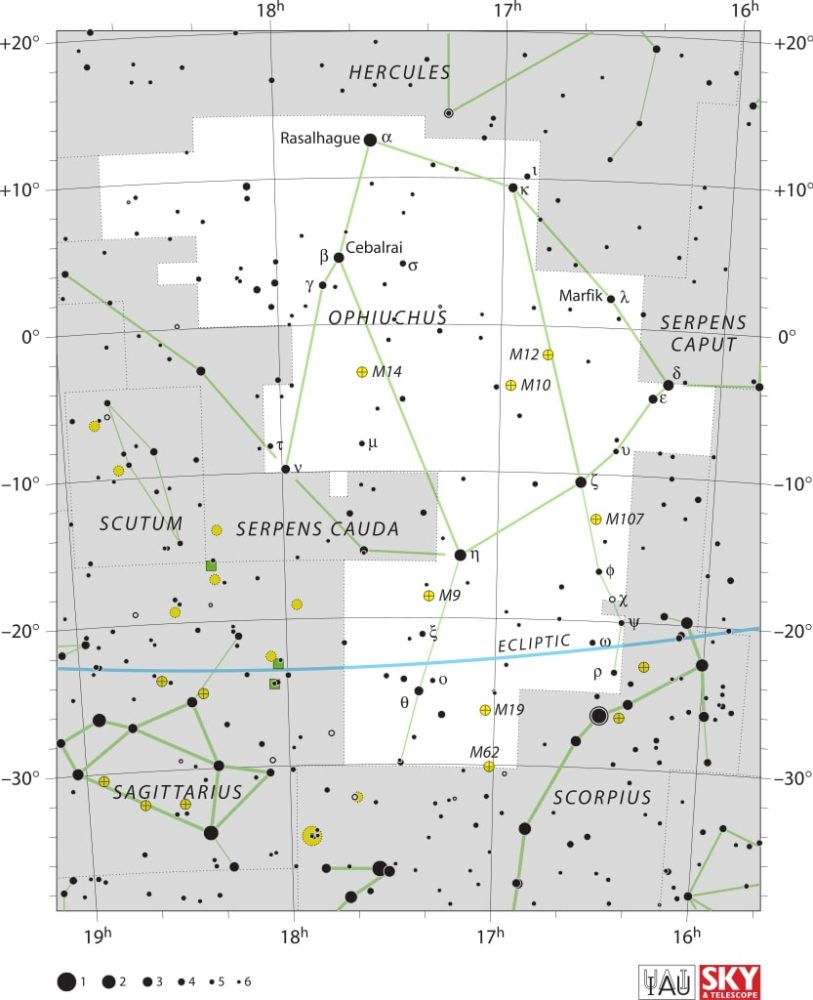
February 15: Conjunction of the Moon and Jupiter
The Moon and Jupiter will be at conjunction by sharing the same right ascension and passing within 3°09′ of each other.
At around the same time the two bodies will also make a close approach (appulse) reaching 2°53′ from each other, but not sharing the same right ascension.
The two celestial bodies will meet in the constellation Aries with the Moon at apparent magnitude of -11.6 and Jupiter at -2.3. The Moon will be a 6 days old waxing crescent at 41%.

February 15: Conjunction of Mars and Pluto
Mars and Pluto will be at conjunction by sharing the same right ascension and passing within 1°55′ of each other.
The two bodies will meet in the constellation of Capricornus with an apparent magnitude of 1.3 for Mars and 15.2 for Pluto. The Moon will be a 6 days old waxing crescent at 40%. (Constellation map already displayed above, when discussing the conjunction of Mercury and Pluto.)
February 16: Close approach of the Moon and the Pleiades
The Moon and the Pleiades (also known as M45 or Messier 45) will make a close approach, passing within only 30.9 arcminutes of each other.
Both objects will be in the constellation of Taurus with the Moon being at apparent magnitude -12.0; and the Pleiades at 1.3. The Moon will be 7 days old and waxing gibbous at 57%.

February 17: Conjunction of Venus and Pluto
Venus and Pluto will be at conjunction by sharing the same right ascension and passing within 2°42′ of each other.
The two bodies will meet in the constellation of Capricornus with an apparent magnitude of -3.9 for Venus and 15.2 for Pluto. The Moon will be 8 days old waxing gibbous at 70%. (Constellation map already displayed above, when discussing the conjunction of Mercury and Pluto.)
February 22: Conjunction of Venus and Mars
Venus and Mars will be at conjunction by sharing the same right ascension and passing within 38′ of each other.
At around the same time the two bodies will also make a close approach (appulse) reaching 37.4 arcminutes from each other, but not sharing the same right ascension.
The two planets will meet in the constellation of Capricornus with an apparent magnitude of -3.9 for Venus and 1.3 for Mars. The Moon will be 13 days old waxing gibbous at 98%. (Constellation map already displayed above, when discussing the conjunction of Mercury and Pluto.)
Moon Phases in February 2024
As you know, the Moon has a big impact on the visibility of celestial bodies and astronomical events in the night sky. So here’s a calendar of the phases of Moon for this month of February 2024:

Positions of the Planets in February 2024
Mercury: The closest planet to the Sun can be seen at dawn and dusk travelling across the constellation of Capricornus and then Sagittarius later in the month. This planet, being the closest to the Sun, will appear to move quickly in the night sky and its position will change in the following weeks.
Venus: The sister planet can be seen travelling across the constellation of Sagittarius and then Capricornus. Just like Mercury, Venus can only be seen at dawn and dusk.
Mars: The red planet can be seen in the constellation of Sagittarius and then Capricornus.
Jupiter: The gas giant is visible in the constellation of Aries. Jupiter can easily be spotted with the naked eye, even in highly illuminated cities.
Saturn: The ringed giant can be seen with the naked eye in the constellation of Aquarius.
Uranus: The ice giant can be seen in the constellation of Aries with the use of a telescope.
Neptune: The blue giant requires a telescope pointed in the constellation of Pisces in order to be seen.
Positions of Dwarf Planets and Large Asteroids in February 2024
Ceres: The asteroid belt’s lone dwarf planet can be seen in the constellation of Sagittarius with the help of a telescope.
Vesta: This large asteroid can be seen in the constellation of Taurus with a telescope.
Pallas: The asteroid can be observed with a telescope in the constellation of Serpens.
Pluto: This distant dwarf planet can be found in the constellation of Capricornus with the help of a large telescope.
Major astronomical events next month – March 2024
- March 3: Asteroid 3 Juno at opposition.
- March 12: Asteroid 23 Thalia at opposition.
- March 14: γ-Normid meteor shower peak.
- March 19: March equinox.
- March 24: Mercury at greatest eastern elongation.
- March 25: Penumbral lunar eclipse.
- March 30: Makemake at opposition.
Conclusion
Stargazing in the month of February 2024 promises to be a captivating journey through the cosmos, offering both seasoned astronomers and amateur skywatchers alike an opportunity to marvel at the wonders of the universe. As we gaze upward and contemplate our place in the vast expanse of space, let the celestial events of this month inspire wonder and curiosity, reminding us of the boundless beauty that surrounds us.
Happy stargazing! And don’t forget to subscribe to our newsletter below to receive our stargazing calendar in your mailbox.
Sources:
- Planetary ephemerides produced by NASA’s Jet Propulsion Laboratory (JPL)
- International Meteor Organization
- NASA JPL Small-Body Database Lookup
See also:
- Previous month’s calendar: Stargazing Calendar for January 2024
- Next month’s calendar: Stargazing Calendar for March 2024
Would you like to receive similar articles by email?



